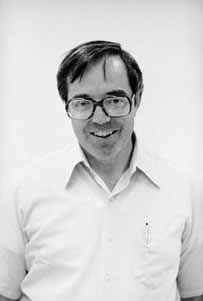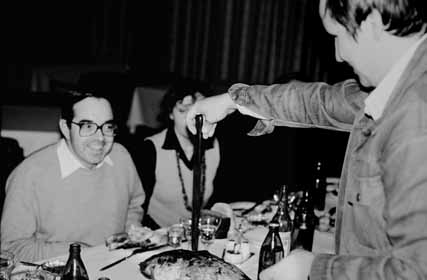 |
|
`Father Tim' Saw Spirituality in Science, Touched the Hearts and Minds of Scientists by Mike Perricone
 Tim Toohig lit a candle wherever he went. He shone the light wherever he thought it was needed, though not always by invitation.
Tim Toohig lit a candle wherever he went. He shone the light wherever he thought it was needed, though not always by invitation.
"He was beloved by everybody, yet he kowtowed to nobody," said Fermilab physicist Joe Lach, a friend since 1965. "He said things the way he saw them, and what he said was usually right." Physicist Tim Toohig-Father Timothy Toohig, S.J.-played a leading role in establishing both scientific and humanitarian standards in the early days of Fermilab. He made indispensable contributions to the design and construction of the Tevatron, then brought his scientific and leadership skills to the Superconducting Super Collider project. At the height of the Cold War, he participated in accelerator experiments in the Soviet Union. In his latest assignment at the U.S. Department of Energy, he made an imprint on yet another generation of high-energy physics forefront machines by serving as Program Manager for the $531 million U.S. involvement in the Large Hadron Collider at CERN, the European Particle Physics Laboratory. Toohig was attending an LHC Program Advisory Committee meeting at Stanford Linear Accelerator Center on the day he died, September 25, 2001. The cause of death was not determined, although a stroke was suspected. In the evening following the PAC meeting, Toohig collapsed while speaking with colleague Tom Eliioff in the parking lot. He was taken by ambulance to Stanford Hospital, where he appeared alert and talkative. He passed away later that evening. He was 73. Toohig received his doctorate in physics from Johns Hopkins University in 1962. He was ordained into the priesthood in 1965. Throughout a career spanning four decades, his spiritual guidance was as valued as his scientific knowledge. Toohig presided at memorial services at Fermilab for founding Director Robert R. Wilson in May, 2000, and Wilson had once described him as "spiritual counselor for the project" of building the laboratory. Lach related that Toohig had officiated at the funeral services for his wife, Barbara, and was preparing to preside at the wedding of his daughter, whom he had baptized when she was an infant.
"Father Tim" to his extended family throughout the high-energy physics community, Toohig saw no conflict between his pursuit of scientific and spiritual knowledge. While serving at the Department of Energy, he also held a research position at Boston College. He was, in fact, representative of the Jesuit outlook since the order's founding in 1540 by Ignatius Loyola, who considered the acquisition of knowledge a spiritual task. Toohig's scientific papers (including a 1994 article, "Reassigning Blame for the SSCS Demise," in Physics Today) are featured in an exhibit, "Jesuits and the Sciences," compiled by the Science Library of Loyola University of Chicago, and available on the Web (http://www.luc.edu/libraries/science/jesuits/index.html). In his March, 2000 talk at Fermilab ("Physics Research: Searching for God") during the Symposium on the Nature of Science, Toohig noted these parallels: "Both religion and science contain a powerful sense that there is more there than we currently understand. In science, this is what leads us, for example, to build new accelerators, as a way to reach beyond what we know, toward discoveries that we believe lie beyond." During the talk, he reached back to the early 1960s, when he was a graduate student at Johns Hopkins. He was in a group working on the Berkeley Bevatron experiment that discovered the eta meson, a critical step on the path toward establishing the existence of quarks. Toohig and his fellow grad students ran their data during the night shift at NASA's Goddard Space Flight Center, watching those old line printers crank out the results of their calculations. With each result they knew they were seeing something new. "It was a fantastic feeling, better than winning a football game," he recalled. "I couldn't help relating it to experiences in prayer, to the very special moments I'm sure we all have had in our lives, times of real trouble or very special moments when there's this tremendous sense of interior joy and excitement. It could only be described as a deep spiritual experience. With time, I've learned that such experiences are really what physics research is all about, and that's why we do it. The reward is that joy." Toohig is survived by two brothers and five sisters, and a large extended family of physicists who felt a significant portion of their rewards from working with Father Tim. "I counted on him, trusted him, and will miss him more than I can say," said Rich Orr, Fermilab's first assistant director. "The world is a darker place without him." |
| last modified 10/22/2001 by C. Hebert email Fermilab |
FRLsDFx9eyfrPXgV
 "We had dinner together just a few weeks ago at Chez Léon [at Fermilab]," Lach said. "Tim hadn't met my daughter's fiancé, and he wanted to get to know him before officiating at the marriage."
"We had dinner together just a few weeks ago at Chez Léon [at Fermilab]," Lach said. "Tim hadn't met my daughter's fiancé, and he wanted to get to know him before officiating at the marriage."